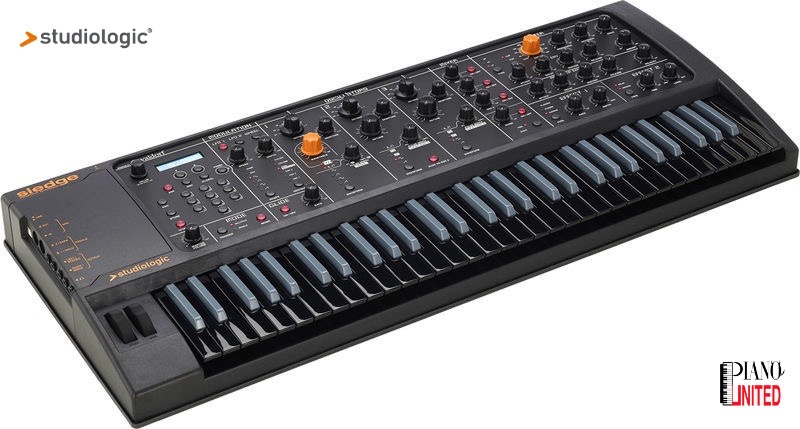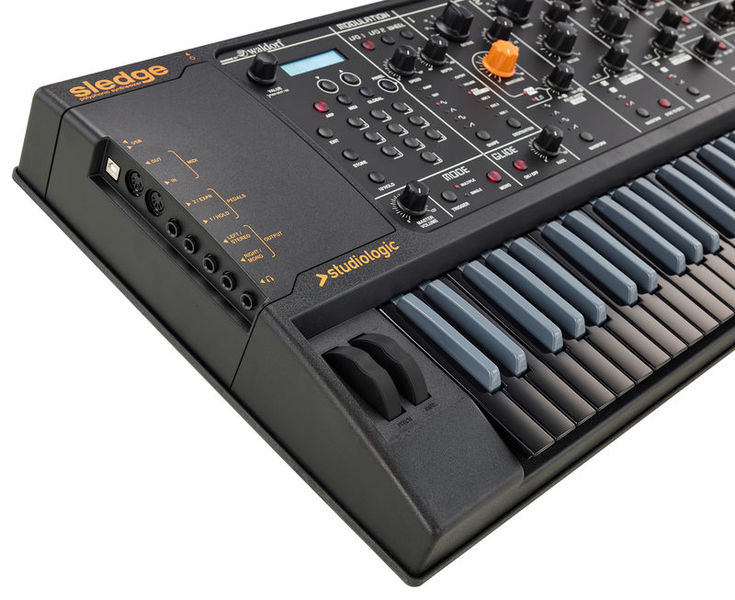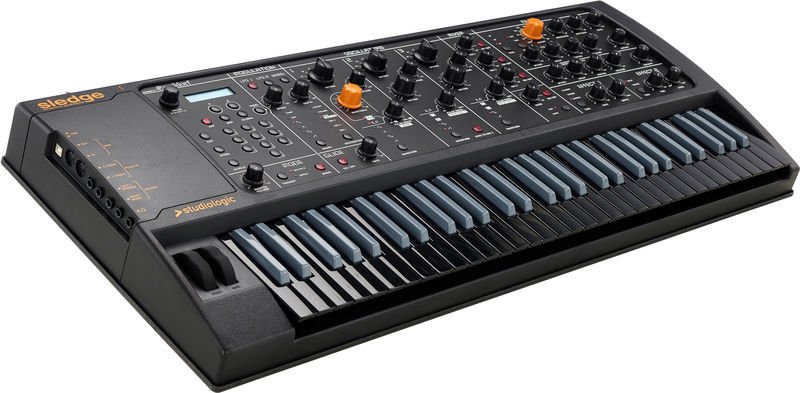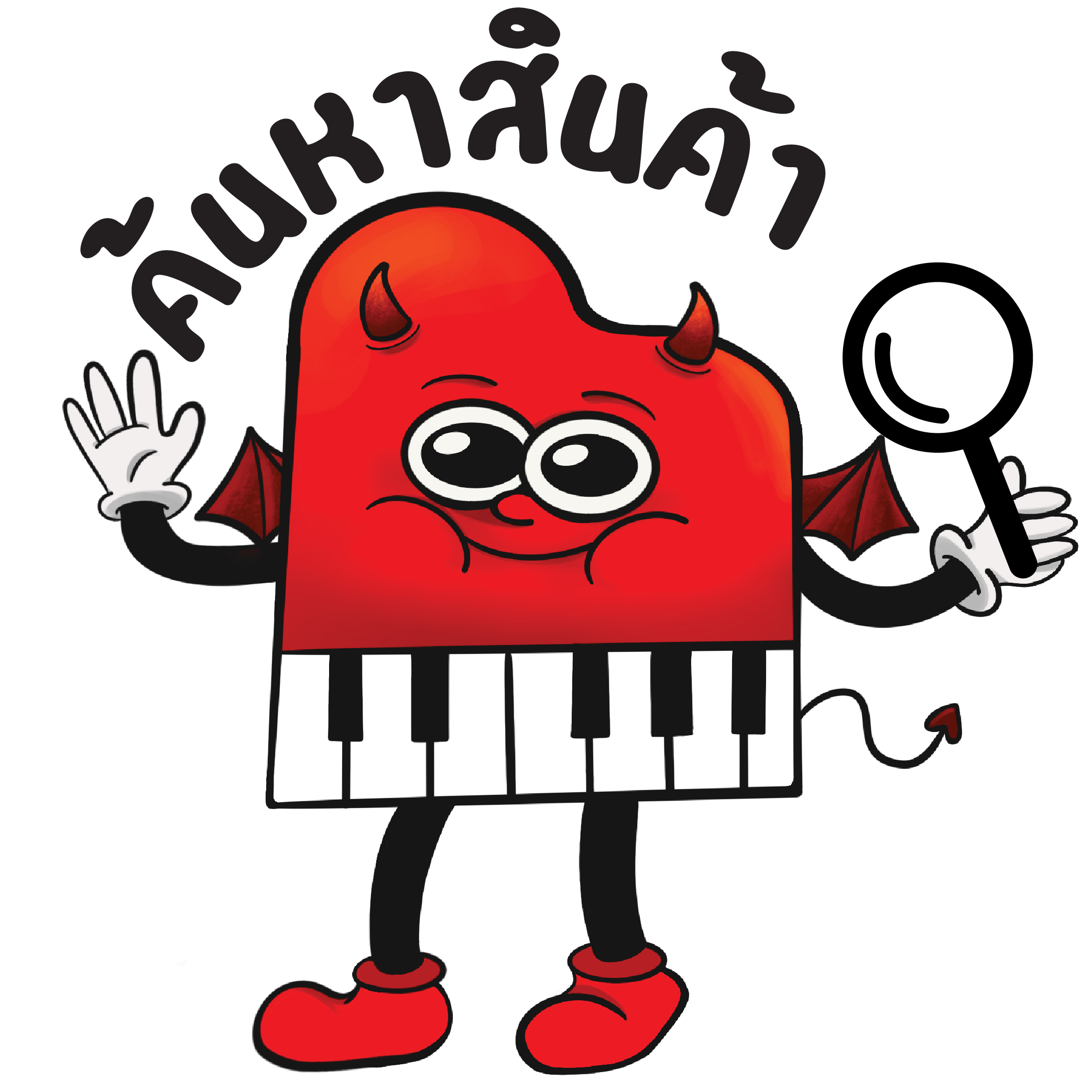
Sledge Black 2
Synthesiser sledge black 2
- 61 Semi-weighted keys
- 24 Voice polyphony
- DSP with Waldorf modeling technology
- 3 Oscillators and a multi-mode filters per voice
- 60 MB Flash memory for Samples
- Dual mode
- Arpeggiator
- 2 Effects simultaneously
- 32 Potentiometers
- Pitch and modulation wheel
- Up to 1000 sounds
- Fatar TP 9 keyboard
- Stereo Line out
- Headphone output
- Expression pedal input
- MIDI In/Out
- USB MIDI
- Dimensions: 97 x 40.5 x 11 cm
- Weight: 8.3 kg
Studiologic Sledge Black Edition
The exclusive dark look includes a black case, a semi-weighted keyboard with reverse black and grey keys and an even more professional touch feeling. New modulation features and sounds, with a mix of pure synthesis and sampling, push Sledge further than ever before.

New color, best touch.
The reverse color keyboard perfectly matches the black look and thanks to semi-weighted keys and new balanced springs, gives an unbeatable feeling, for a more satisfying musical experience.

Double power, bigger sound.
The audio output level is enhanced, for a stronger, cleaner and fatter sound. The LFO2 is now synchronized, allowing to keep the same modulation phase on all notes.

Sounds from the world.
Top musicians have contributed a signature sound-set which, together with the new settings, further improves the warm and crisp sound that made Sledge appreciated worldwide.

Spectre & Sound Mapper
Create and transfer Sample content, manage and reorganize the internal sound library of your Sledge. Load, save, copy, send, receive. Everything you want to do with your sound library, you can do that thanks to a user-friendly interface.

- 61 Keys, TP/9S semi-weighted Action
- Balanced spring action
- Dual switch detection system
- Aftertouch
- Touch
- Soft, Medium, Hard, Fixed (programmable) 1
- Max Polyphony 24 voices
- 2 Parts
- Modulation
- LFO1, LFO2 (phase synchronized), WHEEL (for Mod wheel and Aftertouch)
- Adjustable LFOs speed and depth
- LFO shapes: sawtooth, square, triangle, sine, sample & hold, ramp
- Destinations: OSC1, OSC2, OSC3, PWM / Wave / FM, Volume, Filter Cutoff
- Oscillators (OSC1, OSC2, OSC3)
- Range from 64′ to 1′ with semitone and detune controls
- Shapes: sawtooth, square, triangle, sine, pulse (with pulse modulation)
- OSC1 with 66 original PPG Wavetables + Sample Player (60 Mb internal memory)
- FM (Tone generation): OSC2, OSC3 amount control – Oscillator hard sync (OSC2 to OSC3)
- Mixer
- Volume and On/Off switch for each oscillator
- Noise generator: White/Pink – Volume control
- Filter & Amplifier
- Slope (24/12 db) – lowpass, highpass, bandpass
- Resonance up to self oscillation
- Adjustable key track and drive
- Filter envelope – ADSR with amount control
- Amplifier envelope – ADSR with velocity control
- Proportional velocity control on Filter and Amplifier sections
- Arpeggiator
- Latch mode
- Syncable to MIDI clock
- Direction up, down, alternate
- Range up to 10 octaves
- 2 simultaneous effects
- FX1: Chorus / Phaser / Flanger
- FX2: Reverb / Delay / Reverb + Delay
- 999 User Programs (+13 Categories)
- Fast sound selection via numeric keypad or encoder
- Auto Dual Mode – Split/Layer – programmalbe Split pount for each program
- Global
- Master tune – Transposer – Pitch/Bend range – Pedal functions (volume, mod wheel, cutoff) – Pot mode (snap/direct) – Display time – Pitch wheel, hold pedal assign
- MIDI
- MIDI Channel – Local On/Off – Clock control – Send/Receive controls
- Display 2×16 digits backlit LCD
- Pitch wheel
- Modulation wheel
- 35 Pots
- 3 “chicken head” rotary switches (7 positions)
- 1 rotary encoder with push function
- Master volume control (with panic and anti-thump circuit)
- Numeric keypad
- Audio OUT: 2x 6,3 mm mono jack (L+R)
- Headphones: 2x 6,3 mm stereo jack
- Pedals: Hold, Expression
- MIDI: In, Out
- USB: USB to Host, MIDI
- AC IN: 110-240V
- Width: 97 cm / 38,2″
- Depth: 40,5 cm / 16″
- Height: 11 cm / 4,5″
- Weight: 9,3 Kg / 20,5 lbs
- Sledge 2.0
- Power cord
Sledge 2.0 New features
Auto Dual mode: Sledge 2.0 can now play two sounds at the same time, in Split or Layer mode; the feature is controlled by a new page of the Global function and allows to simply keep one note (for Split) or more notes (for Layer) and then select a new sound, that will be added to the previous
sound; as any other sound, also Dual Sound combinations can be permanently stored in any of the 1.000 available presets;
Global Pitch & Hold controls: a new Global page allows to enable the Pitch and the Hold separately for the Lower and Upper sounds in Dual Mode, allowing to use the Pitch bend on the Upper sound (i.e. for solo parts) and the Hold pedal to control only the Lower (to keep playing a Drums groove or as a Damper for a Piano sound) and vice versa, or to enable Pitch Bend and Hold on both Upper and Lower sounds;
Reverb+Delay: a new function allows to mix both effects; the Reverb keeps the setting previously selected, while the real time controls (time and level) allows to set the parameters of Delay also when mixed to the reverb.
โหมดคู่อัตโนมัติ: ตอนนี้ Sledge 2.0 สามารถเล่นสองเสียงพร้อมกันในโหมด Split หรือ Layer; คุณลักษณะนี้ถูกควบคุมโดยหน้าใหม่ของฟังก์ชัน Global และช่วยให้สามารถเก็บบันทึกย่อ (สำหรับ Split) หรือบันทึกอื่น ๆ (สำหรับ Layer) แล้วเลือกเสียงใหม่ที่จะเพิ่มไปยังส่วนก่อนหน้า
เสียง; เช่นเดียวกับเสียงอื่น ๆ การผสมผสานเสียงคู่สามารถจัดเก็บอย่างถาวรในพรีเซ็ตที่มีอยู่ 1,000 รายการ;
การควบคุม Pitch & Hold ทั่วโลก: หน้า Global ใหม่ช่วยให้สามารถเปิดใช้งาน Pitch และ Hold แยกกันสำหรับเสียง Lower และ Upper ในโหมด Dual ทำให้สามารถใช้ Pitch Bend กับเสียงบน (เช่นสำหรับชิ้นส่วนเดี่ยว) และแป้นเหยียบ Hold ควบคุมเฉพาะท่อนล่าง (เพื่อเล่นกรู๊ฟกลองต่อไปหรือเป็นแดมเปอร์สำหรับเสียงเปียโน) และในทางกลับกัน หรือเพื่อเปิดใช้งาน Pitch Bend ค้างไว้ทั้งเสียงบนและล่าง
Reverb + Delay: ฟังก์ชันใหม่ช่วยให้ผสมเอฟเฟกต์ทั้งสองได้ Reverb จะคงการตั้งค่าที่เลือกไว้ก่อนหน้านี้ ในขณะที่การควบคุมแบบเรียลไทม์ (เวลาและระดับ) อนุญาตให้ตั้งค่าพารามิเตอร์ของ Delay ด้วยเมื่อผสมกับ Reverb
Samples: sound samples and new waves can be loaded in the internal 60 megabyte of Flash memory, played by OSC 1 and modifiable by all parameters of the control panel, adding other oscillators, setting filters, envelopes and effects. This feature can constantly expands the instrument’s sounds and create a totally new combination of synthesis and sampling.
Sledge Spectre: samples can be edited (keyboard range, tuning and other parameters) and transmitted to Sledge 2.0 by the USB port, with this easy sample editor that allows to first load and play the samples on your Computer and then download them in the instrument’s memory.
Enhanced Polyphony: the total maximum number or notes that can be played at the same time have been expanded to 24, allowing to get a better real time control over the new sound possibilities obtainable from synthesis and sampling together.
Note: the Sample License is pre-installed for all new Sledge 2.0, while it can be downloaded at Waldorf’s site linked below (with a fixed royalty price) and installed in all previous Sledge instruments, while all other new features are included in the firmware version 2.0.
ตัวอย่าง: ตัวอย่างเสียงและคลื่นลูกใหม่สามารถโหลดได้ในหน่วยความจำแฟลชภายใน 60 เมกะไบต์ เล่นโดย OSC 1 และแก้ไขได้ด้วยพารามิเตอร์ทั้งหมดของแผงควบคุม เพิ่มออสซิลเลเตอร์อื่นๆ ตัวกรองการตั้งค่า ซองจดหมายและเอฟเฟกต์ คุณสมบัตินี้สามารถขยายเสียงของเครื่องดนตรีได้อย่างต่อเนื่อง และสร้างการผสมผสานการสังเคราะห์และการสุ่มตัวอย่างแบบใหม่ทั้งหมด
Sledge Spectre: ตัวอย่างสามารถแก้ไขได้ (ช่วงแป้นพิมพ์ การปรับแต่ง และพารามิเตอร์อื่น ๆ ) และส่งไปยัง Sledge 2.0 โดยพอร์ต USB ด้วยตัวแก้ไขตัวอย่างที่ใช้งานง่ายนี้ ซึ่งอนุญาตให้โหลดและเล่นตัวอย่างบนคอมพิวเตอร์ของคุณก่อน แล้วจึงดาวน์โหลดลงในเครื่องมือ หน่วยความจำ.
Enhanced Polyphony: เพิ่มจำนวนหรือตัวโน้ตสูงสุดทั้งหมดที่สามารถเล่นได้พร้อมกันเป็น 24 ตัว ทำให้สามารถควบคุมเสียงที่เป็นไปได้แบบเรียลไทม์ได้ดีขึ้นจากการสังเคราะห์และการสุ่มตัวอย่างร่วมกัน
หมายเหตุ: สิทธิ์ใช้งานตัวอย่างได้รับการติดตั้งล่วงหน้าสำหรับ Sledge 2.0 ใหม่ทั้งหมด ในขณะที่สามารถดาวน์โหลดได้ที่เว็บไซต์ของ Waldorf ที่ลิงก์ด้านล่าง (ด้วยราคาค่าลิขสิทธิ์คงที่) และติดตั้งในเครื่องมือ Sledge รุ่นก่อนทั้งหมด ในขณะที่คุณสมบัติใหม่อื่นๆ ทั้งหมดจะรวมอยู่ในเฟิร์มแวร์ รุ่น 2.0.
Auto Dual mode: the feature allows to play 2 sounds and the same time and is controlled by a new page (n°5) of the Global, set ON at default; to enable or disable the function, rotate the VALUE encoder to set the function OFF or ON.
To create a DUAL SOUND, keep played keys on the keyboard (one key for entering in Split mode or more keys for Layer mode) and select a new sound with the keypad or the rotary encoder (ref: note). The new sound will become the Upper (either in Split or Layer mode) and will be at the right of the split point or “above” the Lower sound for all keys.
Panel & Effects the panel will be active on the Upper sound and the last selected Effects (of the Upper sound) will also be processing the Lower sound, in combination.
Split point set: the single note kept played when selecting the Upper sound will also be the split point for that sound combination.
note: using the keypad to enter the new sound (with the related program change) is a faster and highly recommended procedure, since changing in sequence more than approx. 10 sounds can also modify the lower sound)
When the function is activated (for instance: sound 002 is selected while keeping a note with sound 001) the display will show this kind of configuration, in order to give all needed information on the Dual Sound parameters
Program change and name of Upper sound
Upper sound Lower S=Split category category p.change L=Layer search
Store Dual Sound: Dual sounds combinations can be permanently stored in any available presets, simply following the standard Store procedure, pressing Store and selecting the program change position where you want to store the dual sound.
โหมดคู่อัตโนมัติ: คุณสมบัตินี้อนุญาตให้เล่น 2 เสียงและในเวลาเดียวกันและถูกควบคุมโดยหน้าใหม่ (n ° 5) ของ Global ตั้งค่าเป็นเปิดเป็นค่าเริ่มต้น หากต้องการเปิดหรือปิดใช้งานฟังก์ชัน ให้หมุนตัวเข้ารหัส VALUE เพื่อตั้งค่าฟังก์ชันเป็น OFF หรือ ON
ในการสร้าง DUAL SOUND ให้เก็บปุ่มที่เล่นไว้บนคีย์บอร์ด (หนึ่งปุ่มสำหรับการเข้าสู่โหมด Split หรือปุ่มอื่นๆ สำหรับโหมด Layer) และเลือกเสียงใหม่ด้วยปุ่มกดหรือตัวเข้ารหัสแบบหมุน (อ้างอิง: หมายเหตุ) เสียงใหม่จะกลายเป็นเสียงบน (ไม่ว่าจะในโหมด Split หรือ Layer) และจะอยู่ที่ด้านขวาของจุดแยกหรือ "เหนือ" เสียงล่างสำหรับปุ่มทั้งหมด
แผงและเอฟเฟกต์ แผงจะทำงานบนเสียงบนด้วย และเอฟเฟกต์ที่เลือกล่าสุด (ของเสียงบน) จะประมวลผลเสียงล่างด้วยร่วมกัน
ชุดจุดแยก: โน้ตเดี่ยวที่เล่นต่อเมื่อเลือกเสียงบนจะเป็นจุดแยกสำหรับการผสมเสียงนั้นด้วย
หมายเหตุ: การใช้ปุ่มกดเพื่อป้อนเสียงใหม่ (ด้วยการเปลี่ยนแปลงโปรแกรมที่เกี่ยวข้อง) เป็นขั้นตอนที่เร็วและแนะนำเป็นอย่างยิ่ง เนื่องจากการเปลี่ยนลำดับมากกว่าประมาณ 10 เสียงสามารถปรับเปลี่ยนเสียงล่างได้)
เมื่อเปิดใช้งานฟังก์ชัน (เช่น เสียง 002 ถูกเลือกในขณะที่ยังคงบันทึกด้วยเสียง 001) จอแสดงผลจะแสดงการกำหนดค่าประเภทนี้ เพื่อให้ข้อมูลที่จำเป็นทั้งหมดเกี่ยวกับพารามิเตอร์เสียงคู่
การเปลี่ยนแปลงโปรแกรมและชื่อของเสียงบน
เสียงบน ล่าง S = แยกหมวดหมู่หมวดหมู่ p.change L = ค้นหาเลเยอร์
Store Dual Sound: การผสมผสานเสียงคู่สามารถจัดเก็บไว้อย่างถาวรในการตั้งค่าล่วงหน้าใดๆ ที่มีอยู่ เพียงแค่ทำตามขั้นตอน Store มาตรฐาน กด Store และเลือกตำแหน่งเปลี่ยนโปรแกรมที่คุณต้องการเก็บเสียงคู่













